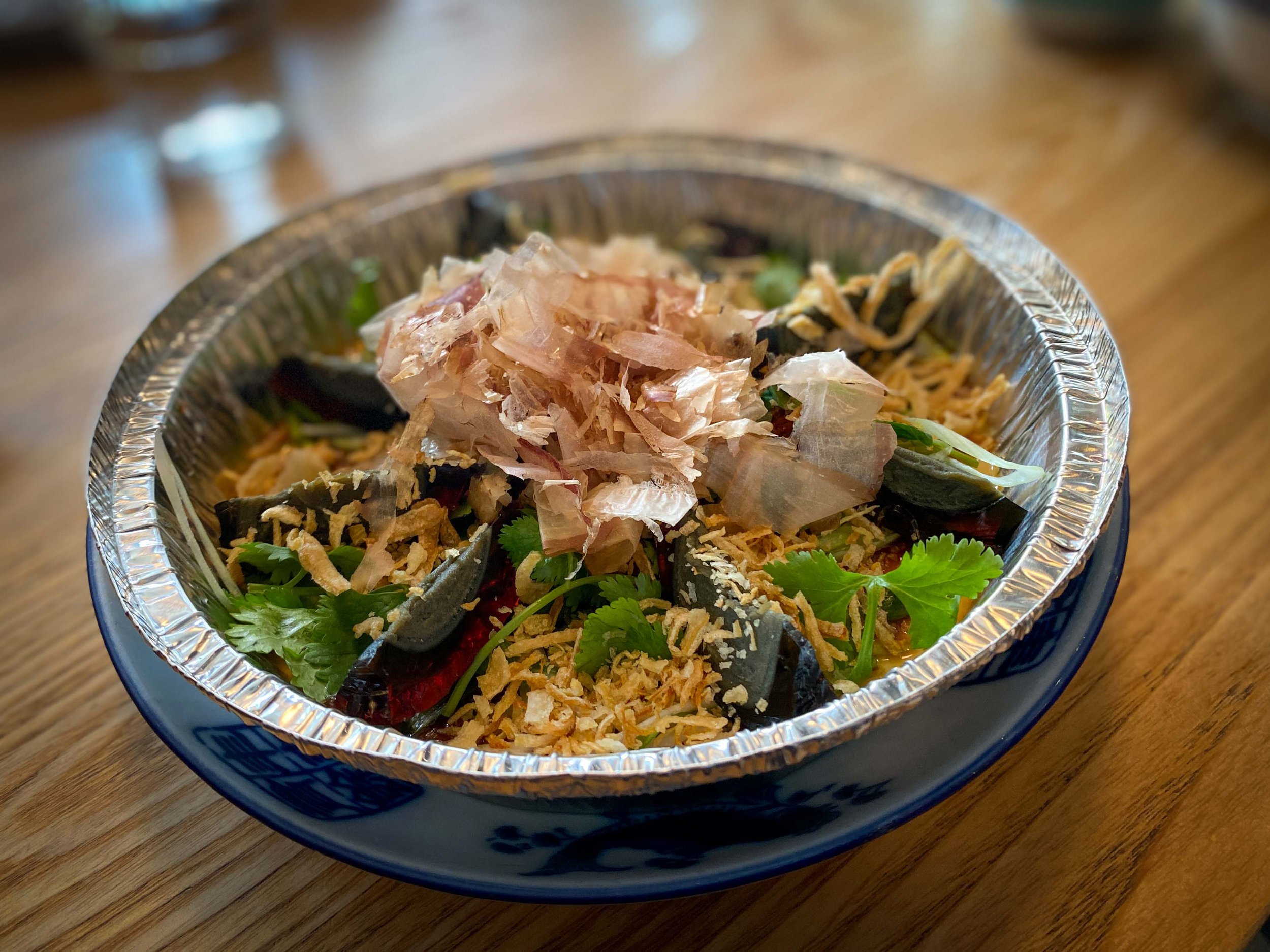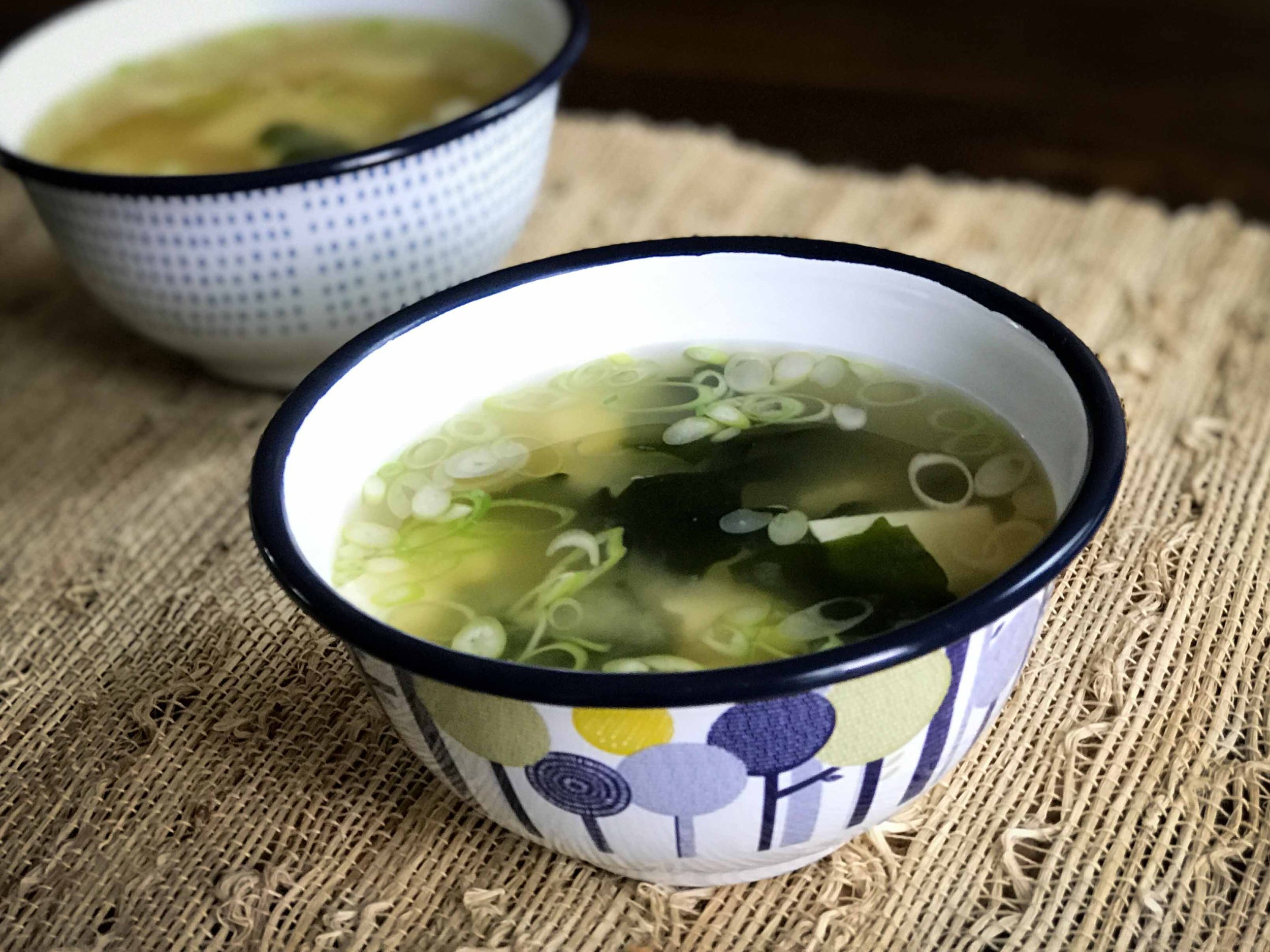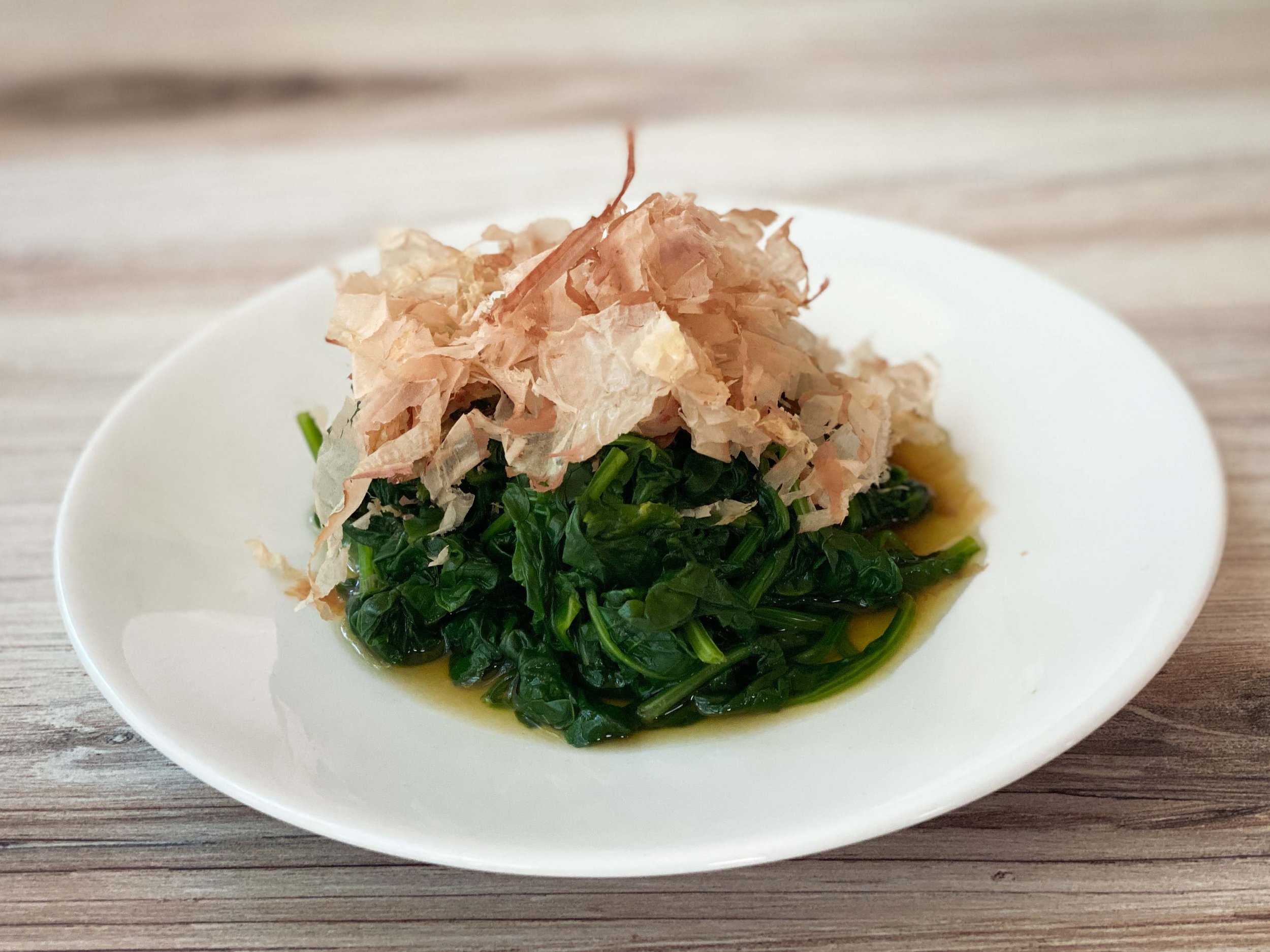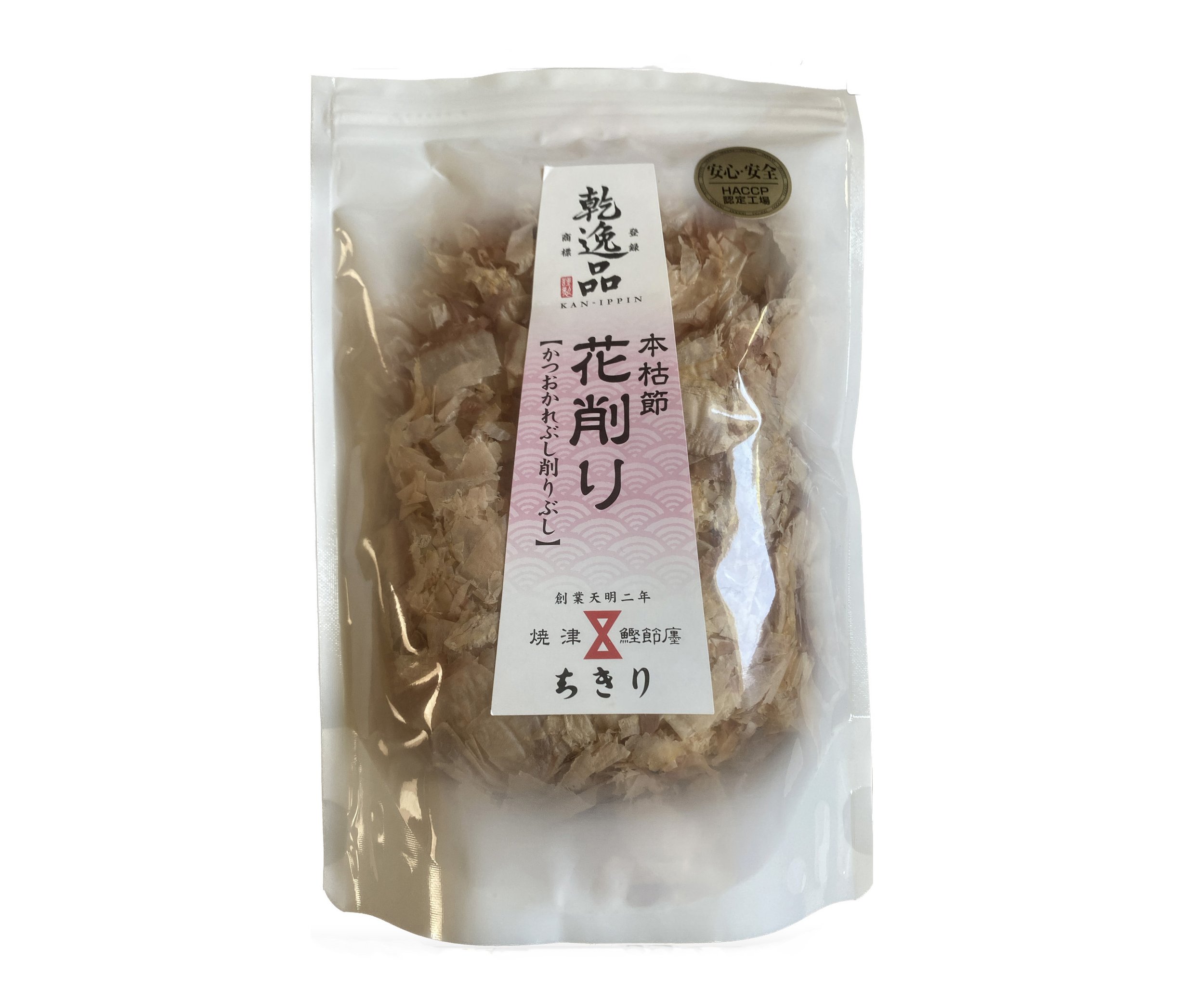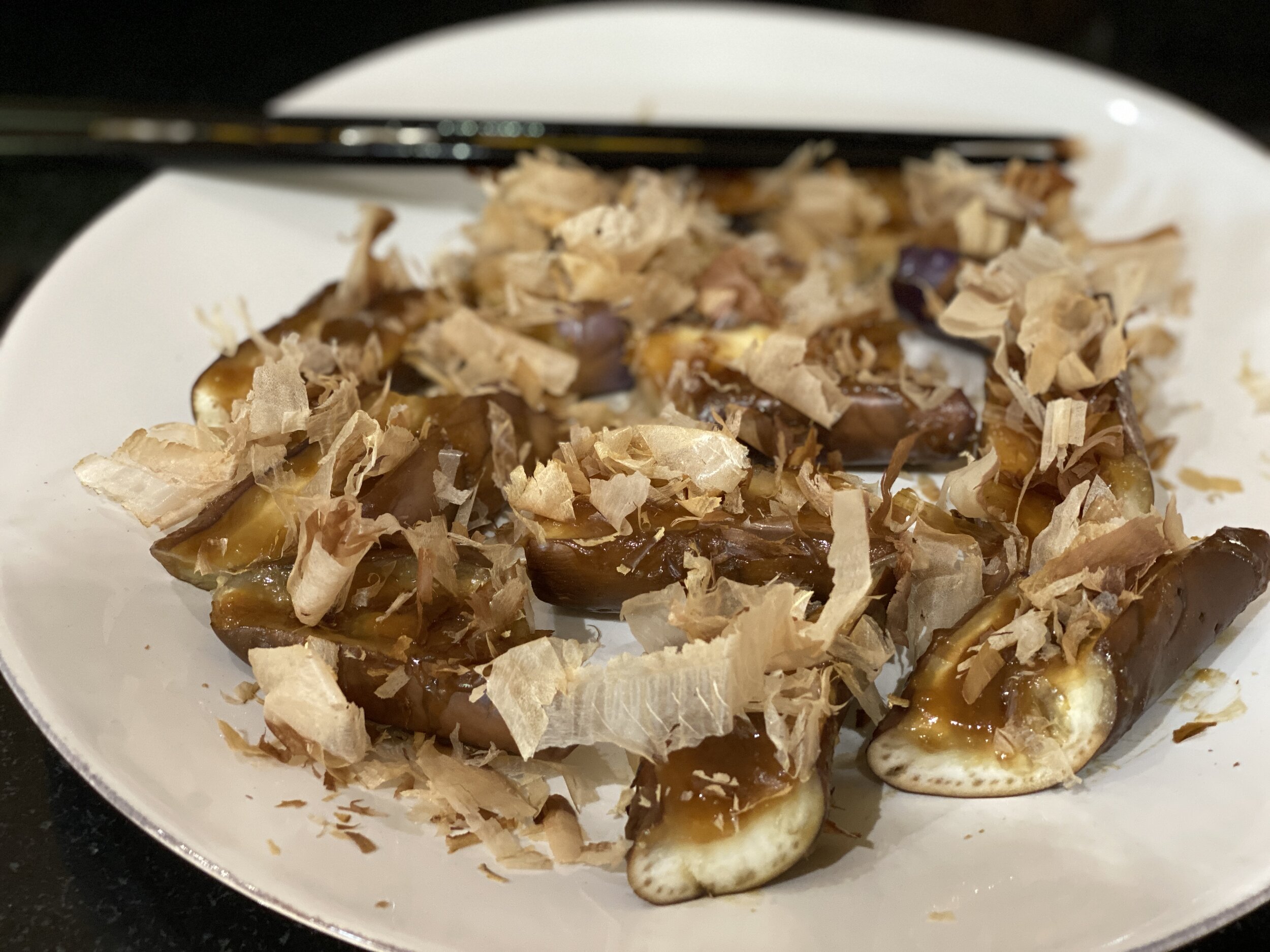Topped with bonito flakes, the Century Egg and House Tofu at Fat Mao in Vancouver (shown above) inspired our recipe for Silken Tofu with Mushrooms and Bonito Flakes.
By Leslie Brenner
Put yourself in possession of a bag of bonito flakes — or katsuobushi, as it’s called in Japanese — and your cooking life may never be the same. Shaggy, delicate and seemingly lighter than air, the ingredient is at once essential and superfluous, ephemeral and timeless. Paradoxical! Shaved bonito looks like sawdust, but it’s way more delicious.
The reason it’s so life-changing, if you’re a certain kind of cook, is that understanding how to use bonito flakes opens up a world of easy and outstanding Japanese dishes, as well as the ability — in the wave of a hand — to drop a mood-altering, umamiful flourish on a fun assortment of other dishes.
Let’s start with the traditional Japanese part of the katsuobushi equation. (Japanese cooks must be chuckling by now, for Japanese cooking simply cannot exist without the stuff.) Bonito flakes are a key component of dashi, the cuisine’s foundational stock. Packed with powerful yet easy-to-control umami, that dashi gives soups and dishes depth and breadth, a soft roundness that makes everything inviting.
Dashi could not be easier or quicker to make: Just steep a piece of kombu briefly in steaming water, drop in a flurry of bonito flakes, wait two minutes, then strain the liquid — dashi achieved. It’s the essential ingredient for miso soup. Just whisk in some miso, drop in tofu and other garnishes (scallions, carrots, onion, spinach, turnips), and it’s done. And delicious. With that dashi in your fridge or freezer, you can make miso soup in a flash, whenever the mood strikes.
Miso soup is made with dashi — of which bonito flakes are an essential ingredient.
Dashi is so essential that it’s the first recipe in many Japanese cookbooks, including star chef Masahuru Morimoto’s excellent Mastering the Art of Japanese Cooking.
The broth may be used to dress spinach, kale or other vegetables (a dish known as ohitashi), make a fabulous dipping sauce for soba, create nimono — Japanese-style simmered dishes, or the heart-warming egg, chicken and rice meal-in-a-bowl called oyoka don. Or pour hot dashi (instead of green tea) over a bowl of garnished rice, for a deluxe version of the homey leftovers-moment called ochazuke.
For anyone eager to dive into Japanese cooking, writes Morimoto, “making dashi should be your first order of business. Your cooking will never be the same.”
Katsuobushi, straight up
Making dashi isn’t the only thing you can do with katsuobushi — you can also use it straight out of the bag. Grab a handful of flakes and drop them on top of okonomiyaki — a savory, saucy pancake stuffed with seafood and vegetables. Watch it dance! The bonito flakes are so light that the heat from the pancake stirs it to catch air currents and wave around on the plate.
Our recipe is adapted from one in Sonoko Sakai’s inspiring book, Japanese Home Cooking.
Shizuo Tsuji’s seminal 1980 book Japanese Cooking: A Simple Art offers a recipe for an ohitashi (those dashi-marinated greens) garnished with katsuobushi. It’s super easy, delicious, fun and dramatic.
RECIPE: Spinach with Dashi and Bonito Flakes
OK, wait — what is katsuobushi exactly?
Yes, let’s back up a moment to talk about the ingredient. Although it’s commonly referred to as bonito flakes or shaved bonito, katsuobushi can be made of either bonito or skipjack tuna; the fish is dried, smoked, sometimes fermented and then shaved. “In the old days,” writes Morimoto, “all cooks bought the fish in blocks that resembled petrified wood and shaved them by hand into fine, feather-like flakes. (Today, most buy preshaved katsuobushi, one modern convenience I can get behind.)”
Some experts write that katsuobushi should be refrigerated once it’s opened, and not kept more than a few days; Morimoto says it lasts “virtually forever” in your pantry. I used to keep — sealed in an airtight container — it in the pantry after opening it, but noticed that after six months or so it dried out. You want the flakes to be soft, not brittle, so I recommend storing it (sealed) in the fridge once it’s open.
You can usually find bags of katsuobushi in Asian supermarkets, usually in cellophane bags with red and white or red and black graphics. Sometimes you can even find them in well stocked generic supermarkets (they have them at the Whole Foods in my neighborhood). You can also find it online (including in the Cooks Without Borders Cookshop). The brands you find most often in Pan-Asian supermarkets and on Amazon are mostly similar in quality, but if you go to an excellent dedicated Japanese supermarket, such as Mitsuwa Marketplace, you can often spend a few more dollars and find katsuobushi of a higher quality (such as the one shown above). To me it’s worth it, especially if you’re using it as a garnish.
Do try these at home
My favorite dish on a recent trip to Vancouver, Canada was at a super-cool, laid-back spot called Fat Mao — Century Egg with House Tofu. (It’s pictured at the top of this story.) The dish consisted of that a thick layer of fabulously creamy house-made tofu topped with cilantro leaves, scallions, crispy fried shallots, a delicious “black garlic sauce,” quartered century eggs and a flurry of katsuobushi. Century eggs, in case you’re not familiar with them, are a Chinese delicacy made by preserving eggs in an an alkaline solution and ash — which renders the yolks intensely flavorful (funky! stinky!) and the whites gelatinous.
I sought to create a dish at home that conveyed a similar vibe, but that didn’t require making or procuring century eggs; I wanted something easy and relatively quick for instant gratification. In place of the century eggs, I found that dry-steamed crimini mushrooms tossed in a sauce made with black garlic was a weirdly excellent analog, providing a chewy-tender texture and loads of umami. Of course the organic silken tofu I picked up at the supermarket didn’t hold a candle to Fat Mao’s house-made tofu, but altogether I think the dish works really well.
Finally, there’s chef José Andrés’s Dancing Eggplant — from his 2019 cookbook Vegetables Unleashed. Quick to make — by zapping Japanese eggplants in the microwave till tender, slathering them with a sweet, salty glaze, then topped with katsuobushi. And yep, it gets its name from the fact that the bonito flakes wave around like they’re dancing on of the eggplant.
If you like this story, we think you’ll enjoy:
READ: On a hot summer evening, nothing refreshes like a basket of chilled oroshi soba
READ: Sonoko Sakai’s ‘Japanese Home Cooking’ is one of the best new cookbooks to come along in years
ALL JAPANESE RECIPES FROM COOKS WITHOUT BORDERS

